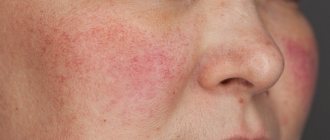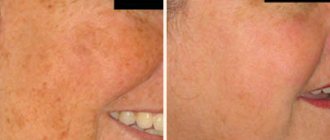Excessive sweating can cause not only discomfort and inconvenience, but also lead to loss of ability to work, as many actions become impossible. For example, increased sweating of the palms of musicians and computer specialists can lead to the inability to perform professional duties. Excessive sweating can also cause everyday problems. After all, even a simple handshake will be “torture” if the hand becomes treacherously wet. Such people try to avoid shaking hands. Excessive sweating is often accompanied by a specific odor. Although sweat itself is a colorless and odorless liquid. An unpleasant odor occurs solely as a result of the activity of microbes that decompose organic substances on the surface of the skin. Eliminating hyperhidrosis also solves the problem of unpleasant odor.
Surgical treatment of axillary hyperhidrosis using the FOTONA Nd:YAG XP 2 laser
Sweating is a normal function of the body to cool and regulate temperature. Excessive sweating is a generalized or localized disorder where the sweat glands work above normal levels. In case of systematic hyperhidrosis
treatment of this simple disorder is necessary, and although in case of proper hygiene and wearing clothes made from natural materials, it is enough to use antiperspirants, but in order to completely remove this disorder, surgery is necessary.
Hyperhidrosis
in the armpit area - this is a very unpleasant condition for men and women of all ages, especially during the summer.
An additional inconvenience is the appearance of sweat stains on clothes around the armpits. Hyperhidrosis
can be either constant or recurring.
Due to trends in modern society and communication media, a quality solution for hyperhidrosis
in the armpit area.
When botulinum toxin is injected into the armpits, hyperhidrosis
temporarily disappears for a period of 4 to 8 months.
Of the available surgical methods, the most widely used method is thoracic sympacectomy, but it has some contraindications (pneumothorax).
Removal of subcutaneous tissue is the most commonly used method of local surgery, with or without skin removal, or a partial combination of both procedures.
Permanent removal of axillary hyperhidrosis
and partial hair removal are resolved through a minor surgical procedure using local swelling anesthesia and the Fotona Nd:YAG XP 2 laser. Considering the minimal invasiveness of this procedure, its permanent nature and subsequent partial hair removal, this procedure is the most recommended treatment for axillary
hyperhidrosis.
Laser treatment for hyperhidrosis: how it works
Laser treatment of hyperhidrosis is a surgical method and is performed in the operating room under local anesthesia in a completely sterile environment.
Surgery for hyperhidrosis involves treating the problem area (we are talking about the armpits) with a concentrated beam of light waves.
With this operation, two types of sweat glands are eliminated: eccrine, which produce abundant and odorless sweat, consisting of 99% water, and apocrine, which emit a sebaceous secretion that can smell very sharp and repulsive.
Sweat glands after laser treatment of hyperhidrosis are not able to regenerate, so the patient no longer faces the problem of abnormally active sweating.
At first, some patients are confused by the prices for laser treatment of hyperhidrosis, but after assessing the high effectiveness of the procedure and the durability of the effect, they choose this method.
Indications and contraindications for laser treatment of hyperhidrosis
Indications for laser treatment of sweating are underarm hyperhidrosis.
Contraindications to laser treatment of hyperhidrosis:
- oncological diseases;
- inflammation of the sweat or sebaceous glands in the area of interest;
- dermatological diseases, skin damage;
- acute infections;
- exacerbation of chronic ailments;
- diabetes mellitus in the stage of decompensation;
- blood diseases, bleeding disorders;
- pregnancy and lactation;
- age under 18 years;
- taking certain medications.
Operation
5 mm incisions are made in the skin in three (3) places - one in the shoulder, one closer to the chest and another on either the abdominal or dorsal side of the armpit.
The procedure itself is divided into three (3) segments:
- Separate the skin from the deeper layers using a spatula.
- Using the Fotona Nd:YAG XP 2 laser.
- Curettage of the subcutaneous level using a serrated suction test with suction.
Incisions and direction of laser movement during the procedure.
This procedure is repeated identically in all three (3) incisions (level is determined at three points), so that the laser moves from each incision in different directions to cover the entire sweat gland area.
Operation with laser fotona nd:yag xp 2 fiber 400.
Progress of the laser cannula.
The sides of the incision are pressed together and a sterile bandage is applied.
There are primary and secondary hyperhidrosis.
Secondary hyperhidrosis occurs as a result of any pathological conditions during the development of diseases. For example, sweating in infectious diseases, tuberculosis, tumors, diseases of the thyroid gland, adrenal glands, pituitary gland. As a rule, such sweating is general in nature, persists at night and disappears when the underlying disease is cured.
Primary hyperhidrosis is a genetically determined condition that in no way indicates a disease in the human body. This feature is predominantly associated with increased activity of the sympathetic nervous system, leading to an increased reaction to any stress, any excitement in the form of increased functioning of the sweat glands.
There are not many methods for treating excessive sweating, and they are well known. There are two groups of methods for treating hyperhidrosis. These are methods of external exposure to the skin (antiperspirants, exposure to current in the form of iontophoresis, botulinum toxin injections). The second group is surgical treatment . Using a combination of these methods, good treatment results can be achieved.
Modern treatment methods have their own specificity in relation to areas of increased sweating. Thus, for the axillary areas, the most effective, convenient and well-accepted treatment method by the patient is the botulinum toxin injection technique (Botox, Xeomin, VTHA, Dysport, Neuronox). But the effect of such treatment will be temporary from several months to six months, and if you are “lucky”, perhaps more. The advantage of this type of treatment is the rapid (literally in 20 minutes) achievement of dry skin effect. But hyperhidrosis will inevitably return again. Botulinum toxin injections are used in the treatment of sweaty palms, here the effect of dry skin will be even more short-lived. Botox is convenient for use on almost any part of the body, especially in “exotic” areas, for example, with hyperhidrosis of the perineal area.
Iontophoresis has been used for a long time in the treatment of sweating of the palms and feet. Sweating goes away within 2 – 3 months. The disadvantage of this method is that it is time-consuming for patients (a course of treatment must be completed). Up to 5% of patients refuse to continue treatment due to the pain of the procedures. This type of treatment cannot be used in patients with cancer, in patients with an artificial pacemaker, in patients with large metal implants.
Price for hyperhidrosis in Moscow
- Botox. Dysport. Xeomin / Hyperhidrosis / Full face
Read the terms of the promotionName of service Promotion price, rub. price, rub. Botox/ unit 410 Xeomin/unit 390 Dysport/unit 150 Myotox/unit 400 Full Face using botulinum toxins 28 100 37 500 Correction of hyperhidrosis/500 units 30 550 35 950 Correction of hyperhidrosis/ 400 units 30 950 Make an appointment
conclusions
It is important to note that 12 months after the final procedure, in all patients, sweating indicators, rated 3 and 4 on the HDSS scale before treatment, decreased to levels 1 and 2 and remained there subsequently. This result is confirmed by the data of the iodine-starch test. To provide statistically reliable data, a larger number of patients and standardization of treatment parameters, as well as a wider sample of histological studies, are needed.
One of the advantages of the FractoraDry device is that the depth of the radiofrequency thermal treatment can be controlled and applied to the desired target without causing damage to the epidermis. Based on this, it has been suggested that FractoraDry could be used to permanently damage the sweat glands and be used as an effective treatment for primary axillary hyperhidrosis.
Literature
- Chilukuri S., Robb CW, Weiner SF, Grossman J. Primary axillary hyperhidrosis treatment using high intensity focused fractional radiofrequency microneedling. J Drugs Dermatol 2018; 17(7):
- Kim M., Shin JY, Lee J., Kim JY, Oh SH Efficacy of fractional microneedle radiofrequency device in the treatment of primary axillary hyperhidrosis: A pilot study. Dermatology 2013.
- Hantash BM, Renton B., Berkowitz RL, Stridde BC, Newman J. Pilot clinical study of a novel minimally invasive bipolar microneedle radiofrequency device. Lasers Surg Med 2009; 41:87–95
- Lolis MS, Goldberg DJ Radiofrequency in cosmetic dermatology: a review. Dermatol Surg 2012; 38:1765–1776.
- Elsaie ML, Choudhary S., Leiva A., Nouri K. Nonablative radiofrequency for skin rejuvenation. Dermatol Surg 2010; 36:577–589.
- Hong HC, Lupin M., O'Shaughnessy KF Clinical evaluation of a microwave device for treating axillary hyperhidrosis. Dermatol Surg 2012; 38: 728–735.
- Doft MA, Hardy KL, Ascherman JA Treatment of hyperhidrosis with botulinum toxin. Aesthet Surg J 2012; 32: 238–244.
Share:
Benefits of botulinum therapy
- Efficiency. It only takes one session to relieve the patient of primary hyperhidrosis.
- Long lasting results. The effect lasts on average up to 6 months, after which the procedure can be repeated - the injections are not addictive.
- Safety. Botulinum therapy has a minimum of contraindications and therefore does not harm human health.
- Conduction speed. The session lasts a few minutes and does not require rehabilitation or lengthy preparation.
- Painless. The treatment is comfortable for the patient; local anesthesia is used to eliminate pain.
Fractora
The use of devices that generate radio wave energy with an application point on microneedles has proven itself in aesthetic cosmetology for the treatment of deep wrinkles, pores and post-acne scars.
The HIFRF technique is FDA approved for the correction of facial wrinkles. Therefore, we hypothesized that it could be considered as an alternative to traditional PAG therapy. To test this hypothesis, we prospectively evaluated the effectiveness of the Fractora tip as a treatment method for PAG.
In our practice, we use a Fractora handpiece with 24 electrodes 3 mm long, made of surgical steel, where each needle is insulated with silicone. The active part of the electrodes is the distal end of the needle, heating only the middle and deep layers of the dermis (and partially the hypodermis), without ablation of the epidermis. Under the influence of radio wave energy, coagulation of both types of sweat glands occurs, and the indirect effect leads to thermolysis of the glands outside the zone of contact with the electrode. This fact is confirmed in histological studies in the form of a decrease in the size and density of both eccrine and apocrine glands.
The microneedles are the positive electrodes and the marginal plates are the negative electrodes. It is this fact that makes it possible to safely use high RF pulse energies without the risk of ablation between microneedles ( Fig. 3 ).
Rice. 3. The distal ends of the needles carry a positive charge, which eliminates the possibility of ablation between them.
It is important that this technique is safe when used in patients with different skin phototypes.
How does the procedure work?
In order to carry out the procedure, no special preparation is required. The skin is anesthetized to reduce pain, and the drug is injected. The Botox injection will not take more than an hour. At this time, a test is included to determine the areas where sweating is excessive.
After the procedure, you may notice some redness of the skin and swelling.
This is all normal and will disappear in a couple of days. This is a normal reaction to injections. After the procedure, it is not advisable to massage the area where the drug was injected for some time. It is also necessary to avoid visiting baths and saunas for a while. Sign up for a consultation
Benefits of Botox injections for hyperhidrosis
These injections have many benefits. Firstly, increased sweat production stops. The impulses that are responsible for excessive sweating are completely blocked. Impulses are simply not transmitted to the glands. Despite the fact that the impulses are blocked, the skin's water exchange is not disrupted. There are no negative effects from Botox, your health will be fine.
Secondly, the effect of Botox injections lasts for quite a long time. For 10-12 months you will forget about what sweating is. You don’t have to constantly douse yourself with deodorants and antiperspirants. After the procedure, there are no scars or traces of intervention left. After the injection, the skin recovers as quickly as possible, without any unpleasant sensations.
Signs of hyperhidrosis
The main symptom of hyperhidrosis is excessive sweating. If the problem is severe, then swelling, pain, redness of the skin, as well as severe anxiety in society may appear.
This condition can worsen in hot weather, at high temperatures, and in severe stressful situations.
Finding the original cause of the disease is very difficult; hyperhidrosis can appear suddenly. Hyperhidrosis is usually most severe in young people. The most common is axillary hyperhidrosis.
The symptoms of the disease may worsen in spring and summer, in the hottest weather. Most often it does not appear all the time. The disease is episodic in nature. Excessive sweating may go away for a while, but then return. Often the appearance of hyperhidrosis is associated with hormone surges and problems with the nervous system.
Contraindications for laser hair removal
Individual intolerance to laser radiation.
- Oncology.
- Insulin-dependent forms of diabetes mellitus.
- Herpes is in the acute stage.
- Epilepsy.
- Pregnancy, lactation period.
- Infectious, chronic diseases in the acute stage.
- Fresh tan.
- Multiple moles.
- Progressive benign skin neoplasms.
- Phlebeurysm.
- Wounds, damage, inflammation of the skin at the site of exposure, including tattoos.
- Predisposition to the formation of keloid scars.
- Systemic intake of medications that increase the photosensitivity of the skin.
- Chronic diseases, genital infections (in case of epilation of the bikini area).









